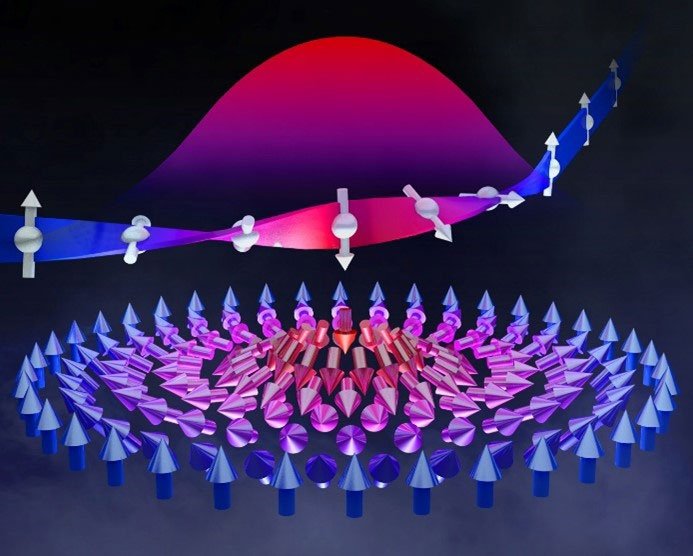| Mar 06, 2023 |
Oxide interfaces put new twist on electron spins
(Nanowerk News) In magnetic solids, electrons feel each other as what scientists call an effective magnetic field. This field forces the electrons’ magnetic moments (spins) to align. If the arrangement of atoms is not fully symmetric, an additional magnetic force known as Dzyaloshinskii-Moriya Interaction (DMI) can emerge. DMI forces the spins to reorient and form whirling patterns called skyrmions.
|
|
Using very careful synthesis methods, researchers joined two different materials, lanthanum manganite (LaMnO3) and strontium iridium oxide (SrIrO3), with atomic precision. The resulting interfaces support DMI, thus enabling skyrmion generation.
|
|
These findings (Science Advances, "Interfacial tuning of chiral magnetic interactions for large topological Hall effects in LaMnO3/SrIrO3 heterostructures") provide insight into the nature of DMIs creating textures with a special type of asymmetry called chirality. They also highlight the emergence of interface-driven topological phenomena.
|
 |
| An electron crossing a skyrmion experiences a fictitious magnetic field that twists its spin and deflects its trajectory, yielding an electrical response known as topological quantum effect. Researchers created these magnetic features in superlattices. (Image: Oak Ridge National Laboratory)
|
|
Skyrmions have dimensions in the nanometer range and behave like particles that can be moved using small electric currents. This means information stored using skyrmions can be manipulated with very small power consumption. Skyrmions are also very resistant against external influences such as temperature and vibrations. Consequently, scientists believe that skyrmions can be used for ultra-high-density information storage devices. The latter will enable devices to encode much larger amounts of data than current computer hard disks.
|
|
Skyrmions can be created by combining two ingredients necessary for DMI to emerge. The first ingredient is lack of inversion symmetry. When dissimilar materials A and B are joined, one creates a system without inversion symmetry. Inverting atom A (or B) with respect to the interface plane produces a different system. The second ingredient calls for electron spins that are strongly influenced by the electron motion around the nucleus. This interaction is called spin-orbit coupling and develops in materials with heavy atoms.
|
|
Researchers at Oak Ridge National Laboratory combined the two ingredients by stacking LaMnO3 and SrIrO3 in a manner that aligns the atoms and their orbitals. They “observed” skyrmions through their signature electrical response known as Topological Hall Effect (THE).
|
|
In THE, an electrical current that crosses the skyrmions experiences an emergent magnetic field, and is deflected sideways, although no external magnetic field is present. By changing the order of each atomic layer, researchers were able to maximize the interface asymmetry and thus the DMI strength, which in turn inferred the creation of smaller and denser skyrmions. This result shows that interfaces can effectively tune DMI strength and tailor skyrmions size to application requirements.
|

